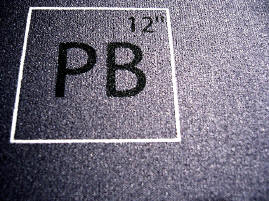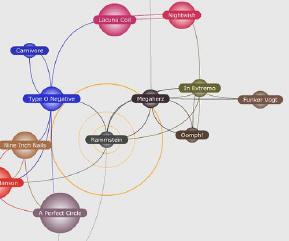Information Visualization
Definition: Information Visualisation is a branch of computer graphics concerned with the development of methods
of presenting data graphically in an interactive or animated form to enable easier understanding.
While there is some overlap between the related fields of information visualisation and scientific
visualisation it is generally understood that information visualisation deals with the representation
of abstract non-spatial data taken from such sources as spreadsheets, databases, etc. Scientific
visualisation primarily deals with the visual representation of ‘real world’
data, such as climate
models and other spatial data.
Development and Use of Information Visualisation
 While it may seem like an obvious statement, enterprises succeed or fail based on the quality of
information they possess. Without adequate knowledge there is little chance for success. However,
in addition to this basic truth it is important to understand that there is a difference between
possessing knowledge and understanding it in such a way as to allow the enterprise to exploit it successfully. While it may seem like an obvious statement, enterprises succeed or fail based on the quality of
information they possess. Without adequate knowledge there is little chance for success. However,
in addition to this basic truth it is important to understand that there is a difference between
possessing knowledge and understanding it in such a way as to allow the enterprise to exploit it successfully.
This is where information visualisation becomes such a powerful tool. Essentially, information
visualisation offers a way to transform raw data into a comprehensible graphical format, allowing
the user to make decisions based on that data.
Perhaps the best example to describe the way in which visualisations can allow us to better
understand data is in Mendeleev’s 1869 Periodic Table of Elements. Mendeleev developed a method by which the known chemical elements could be presented in a grid-like formation, arranged according to their individual attributes. Whether he intended it or not, Mendeleev’s graphical representation of the elements highlighted gaps in our knowledge, allowing scientists to predict where undiscovered elements should fit. By transforming the abstract non-spatial data of chemical elements into a visual representation, Mendeleev created a way for us to better comprehend the data.
This scientific visualisation – graphical visualisation of data from the physical world –
eventually led to the field of information visualisation, which deals with the translation of
non-spatial data into comprehensible graphical formats.
Business Applications
 As mentioned above, the ability to understand and communicate abstract data is essential for the
success of an enterprise. However, information visualisation is much more than just a method of
translating abstract data into a more interesting or visually attractive format. As mentioned above, the ability to understand and communicate abstract data is essential for the
success of an enterprise. However, information visualisation is much more than just a method of
translating abstract data into a more interesting or visually attractive format.
Instead, a founding tenet of information visualisation – and the measure of the success of any
particular visualisation – is that a visualisation should reduce the time required to take in data,
make sense of it and draw conclusions from it. One of the most difficult tasks in developing a
visualisation is in finding a method of presenting data that can achieve these goals.
Decision-makers require business intelligence to make the right decisions in the shortest possible
time. Clearly, then, the ability to communicate dense data in a graphical representation can be of
enormous use to decision-makers.
In order to create such representations it is necessary to build a support network charged with the
gathering and translation of pertinent data. Data miners can compile data on such things as consumer
buying patterns and trends, while the process of translating that data into a graphical format can be
entrusted to information visualisation software.
The Future
As computer technology improves – increasing processing power, better graphics applications and
analysis software – we can expect to see the field of information visualisation move on in leaps
and bounds. New methods of visualising data will eventually push traditional forms of data presentation
(such as spreadsheets and basic graphics) into obsolescence.
The first generation of information visualisation has allowed users to become familiar with basic
forms of graphical representations of data. In the future we can expect to see even more advanced
representations. Today there are many enterprises and academics working to develop new methods of
information visualisation, such as AT&T’s
IV Research Group, the
Pacific Northwest National
Laboratory and
NIST, as well as a wide range of
international conferences focusing on industry-specific
applications.
One possibility is the further development of hardware and software related to the field of
virtual reality. If it becomes possible to create cost-effective and useful virtual reality
devices the future of information visualisation may lie in some sort of ‘full immersion’ technology,
in which the user may enter the representation itself to allow them to better understand and
manipulate visual data. Whether this type of true 3D representation would actually improve the
user’s ability to comprehend the data is as yet unclear, though it does seem likely that in the
near future the field of information visualisation will move beyond the constraints of the 2 dimensional
computer monitor.
|
 While it may seem like an obvious statement, enterprises succeed or fail based on the quality of
information they possess. Without adequate knowledge there is little chance for success. However,
in addition to this basic truth it is important to understand that there is a difference between
possessing knowledge and understanding it in such a way as to allow the enterprise to exploit it successfully.
While it may seem like an obvious statement, enterprises succeed or fail based on the quality of
information they possess. Without adequate knowledge there is little chance for success. However,
in addition to this basic truth it is important to understand that there is a difference between
possessing knowledge and understanding it in such a way as to allow the enterprise to exploit it successfully.
 As mentioned above, the ability to understand and communicate abstract data is essential for the
success of an enterprise. However, information visualisation is much more than just a method of
translating abstract data into a more interesting or visually attractive format.
As mentioned above, the ability to understand and communicate abstract data is essential for the
success of an enterprise. However, information visualisation is much more than just a method of
translating abstract data into a more interesting or visually attractive format.